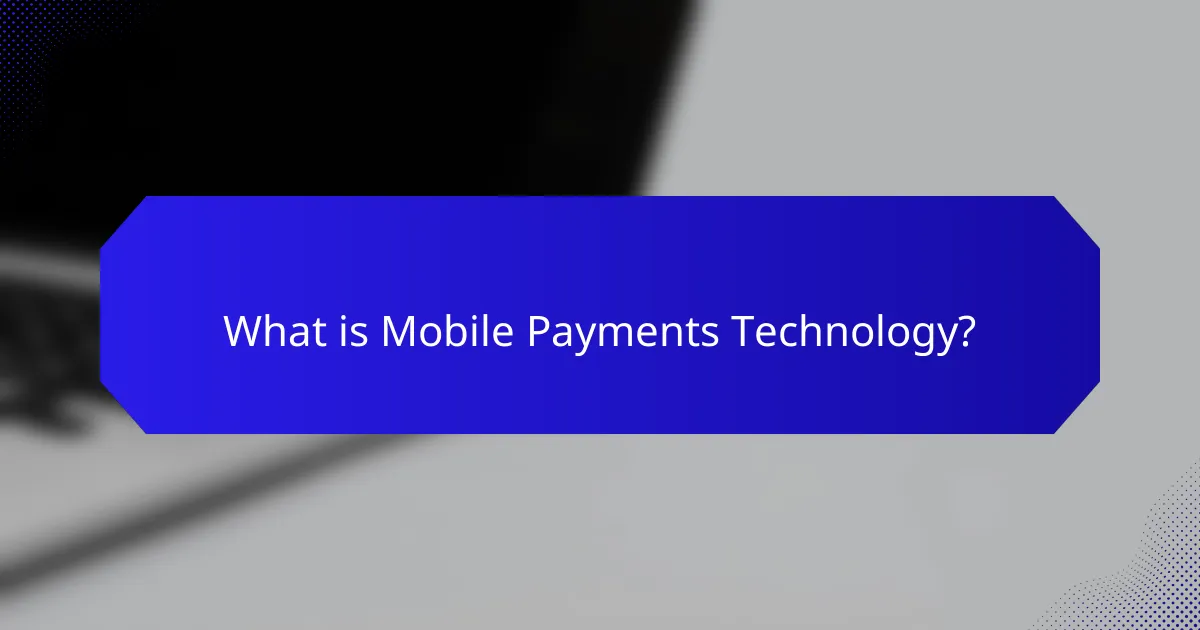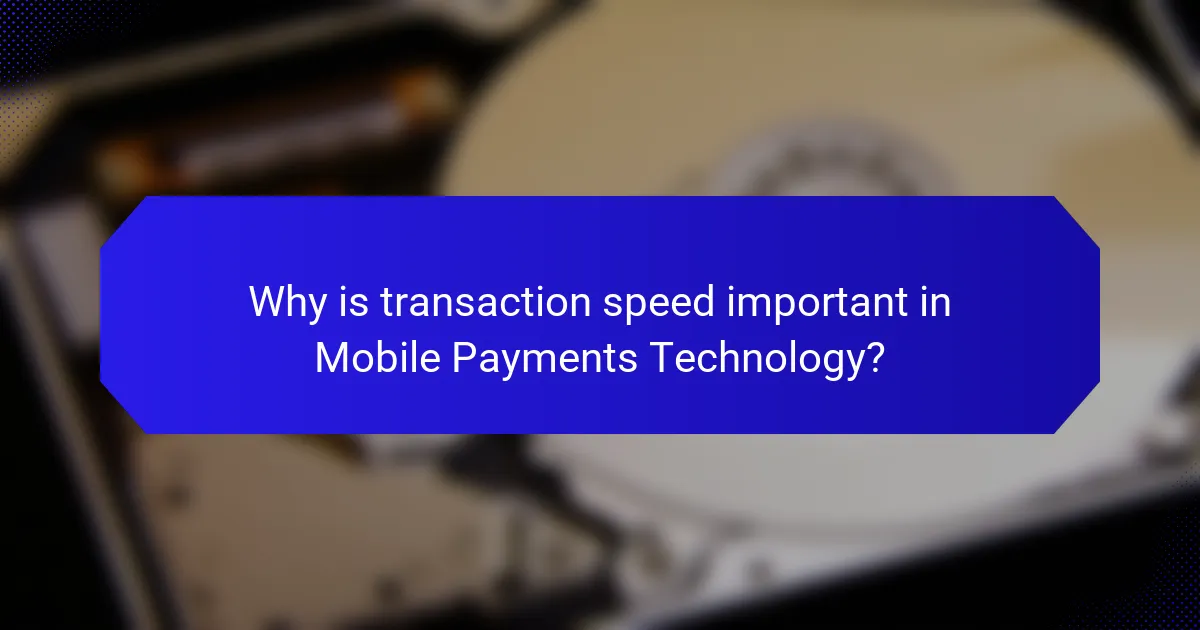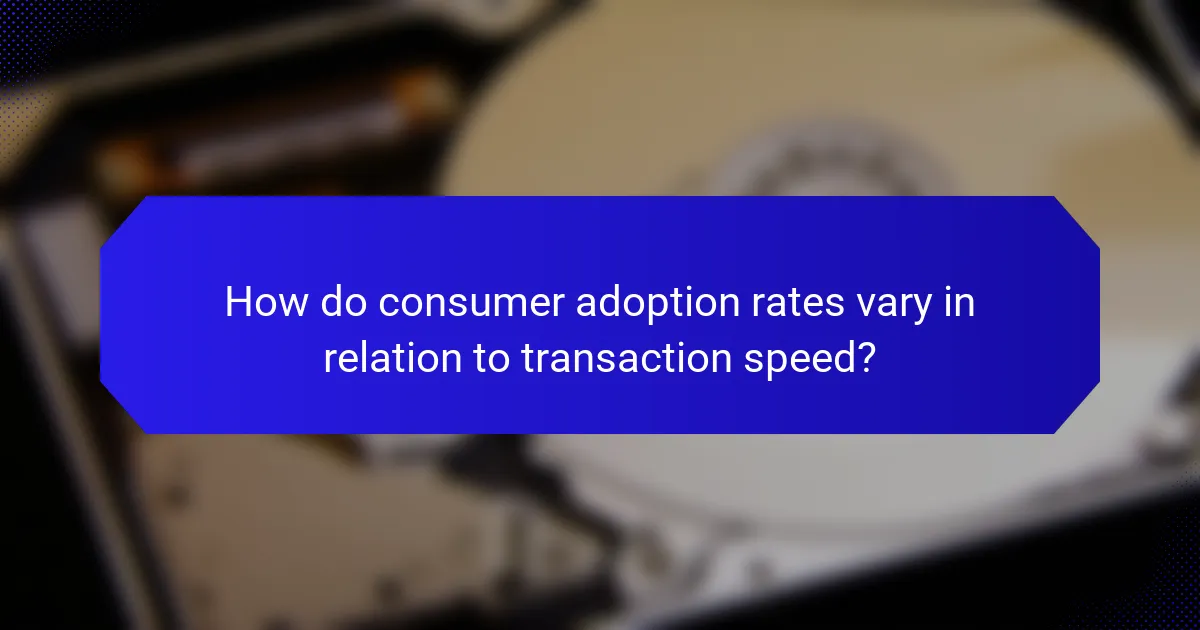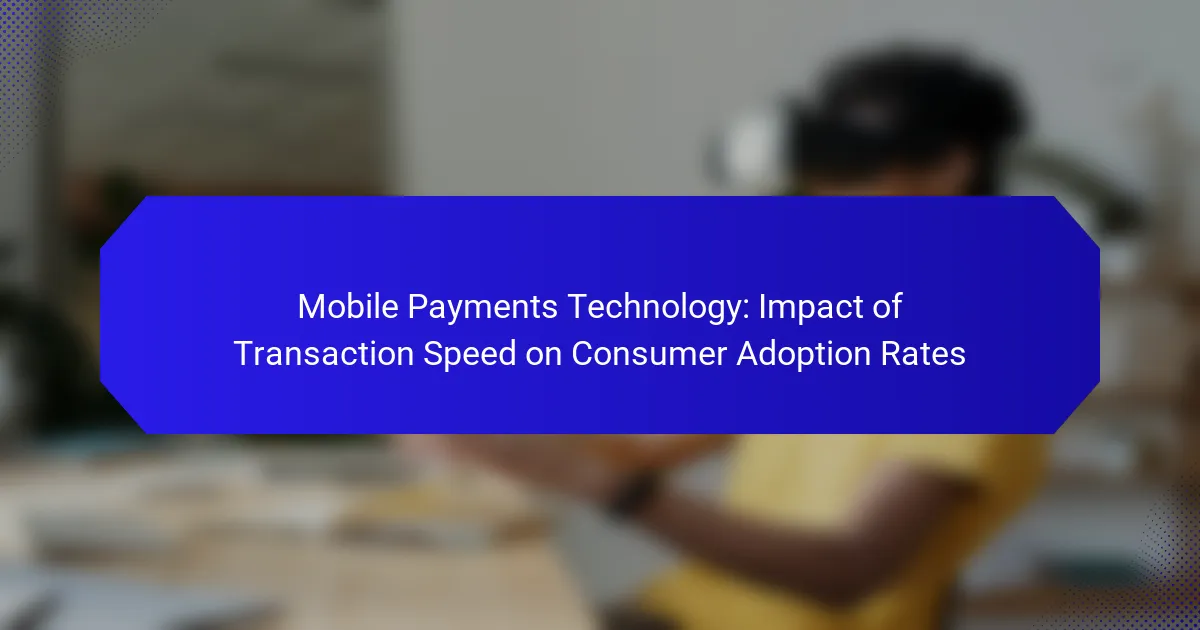Mobile payments technology involves the use of mobile devices, such as smartphones and tablets, to conduct financial transactions. This technology encompasses various methods, including Near Field Communication (NFC), mobile wallets, and QR codes. The article examines the significant impact of transaction speed on consumer adoption rates, highlighting that faster transaction speeds enhance user experience and satisfaction. Research indicates that consumers are more likely to adopt payment methods that process transactions quickly, with studies showing a strong preference for systems that complete payments in under 10 seconds. The correlation between transaction speed and consumer behavior underscores the importance of optimizing mobile payment systems for both user retention and business growth.

What is Mobile Payments Technology?
Mobile payments technology refers to the use of mobile devices to conduct financial transactions. This technology enables users to pay for goods and services using their smartphones or tablets. Mobile payments can occur through various methods, including Near Field Communication (NFC), mobile wallets, and QR codes. According to a report by Statista, the global mobile payment transaction value is projected to reach over $12 trillion by 2025. This growth indicates a significant shift in consumer behavior towards digital payment solutions. Mobile payments enhance convenience and speed, which are critical factors influencing consumer adoption rates.
How does Mobile Payments Technology function?
Mobile payments technology functions by enabling transactions through mobile devices. It uses near-field communication (NFC), QR codes, or mobile wallets to facilitate payments. Users link their bank accounts or credit cards to a mobile application. When making a purchase, the user selects the payment method in the app. The app generates a secure token or QR code for the transaction. This information is transmitted to the merchant’s payment system. The merchant processes the payment and confirms the transaction. According to a report by Statista, mobile payment transaction value is projected to reach $12 trillion by 2024, indicating widespread adoption and reliance on this technology.
What are the key components of Mobile Payments Technology?
Key components of mobile payments technology include mobile wallets, Near Field Communication (NFC), and payment gateways. Mobile wallets store payment information securely on smartphones. NFC enables contactless transactions between devices. Payment gateways facilitate the transfer of payment information between consumers and merchants. Additionally, encryption ensures transaction security, while user authentication methods, such as biometrics, enhance protection. These components collectively support efficient and secure mobile transactions, contributing to consumer adoption.
How do various components interact in Mobile Payments Technology?
Mobile payments technology involves several components that interact to facilitate transactions. These components include the mobile device, payment application, payment gateway, and financial institutions. The mobile device initiates the transaction using a payment application. The payment application encrypts the transaction details for security. It then sends this information to a payment gateway. The payment gateway processes the transaction by communicating with the relevant financial institutions. These institutions verify the transaction and authorize the payment. Once approved, the funds are transferred, completing the transaction. This interaction ensures speed and security, which are critical for consumer adoption. Studies show that faster transaction speeds significantly enhance user satisfaction and increase adoption rates.
What are the different types of Mobile Payments Technology?
There are several types of mobile payments technology. These include Near Field Communication (NFC), which allows contactless payments through smartphones. Another type is Mobile Wallets, such as Apple Pay and Google Pay, that store payment information securely. QR Code payments enable users to scan codes for transactions. Additionally, SMS payments allow transactions via text messages. Peer-to-Peer (P2P) payment systems like Venmo and PayPal facilitate direct transfers between individuals. Each technology offers unique benefits and caters to different consumer preferences.
What are the advantages and disadvantages of each type?
Mobile payment technologies include various types such as NFC, QR codes, and mobile wallets. Each type has distinct advantages and disadvantages.
NFC technology allows for quick transactions with a simple tap. Its advantage is speed and convenience, as users can complete payments in seconds. However, it requires compatible devices and may have security concerns related to contactless transactions.
QR code payments are easy to implement and do not require specialized hardware. Their advantage lies in accessibility and low cost for merchants. However, they can be slower as users must scan codes and may face issues with poor lighting or camera quality.
Mobile wallets offer a comprehensive solution integrating multiple payment methods. Their advantage includes enhanced security features and loyalty program integration. Disadvantages include the need for internet connectivity and potential user resistance to adopting new technology.
Each type of mobile payment technology has its unique strengths and weaknesses, impacting consumer adoption rates based on transaction speed and user experience.
How do these types impact user experience?
Transaction speed in mobile payments technology significantly impacts user experience. Faster transaction speeds lead to increased consumer satisfaction. Users prefer quick and seamless transactions to avoid frustration. A delay can result in abandoned purchases and decreased loyalty. Research indicates that 80% of consumers prioritize speed in mobile transactions. Enhanced speed contributes to a smoother checkout process. This, in turn, encourages repeat usage and higher adoption rates. Overall, transaction speed is critical for optimizing user experience in mobile payments.

Why is transaction speed important in Mobile Payments Technology?
Transaction speed is crucial in mobile payments technology because it directly affects user experience and satisfaction. Faster transaction speeds lead to quicker payment confirmations. This efficiency reduces waiting times at checkout, enhancing convenience for consumers. According to a study by the Federal Reserve, 60% of consumers prefer payment methods that process transactions in seconds rather than minutes. High transaction speed can also increase transaction volumes for merchants, leading to higher sales. In competitive markets, slow payment systems can deter customers, impacting overall adoption rates. Thus, optimizing transaction speed is essential for both consumer retention and business growth.
How does transaction speed affect consumer behavior?
Transaction speed significantly influences consumer behavior. Faster transactions lead to increased customer satisfaction. Quick processing times reduce wait times, enhancing the shopping experience. Studies show that 70% of consumers prefer faster payment methods. Slow transactions can lead to frustration and abandoned purchases. Consumers are more likely to complete transactions when payment is instantaneous. This preference drives the adoption of mobile payment technologies. The convenience of speed encourages repeat business and brand loyalty.
What are the psychological factors influencing consumer adoption rates?
Psychological factors influencing consumer adoption rates include perceived ease of use, perceived usefulness, and social influence. Perceived ease of use refers to how simple consumers believe a technology is to use. Research indicates that when consumers find a technology easy to use, they are more likely to adopt it. Perceived usefulness relates to the extent to which consumers believe the technology enhances their productivity or quality of life. Studies show that higher perceived usefulness correlates with increased adoption rates. Social influence involves the impact of peers and social networks on an individual’s decision to adopt a technology. Evidence suggests that consumers are more likely to adopt technologies that are endorsed or used by their social circles. These psychological factors collectively shape consumer attitudes towards mobile payment technologies, ultimately influencing their adoption rates.
How does transaction speed compare to other factors in consumer decision-making?
Transaction speed significantly influences consumer decision-making, often more than other factors. Fast transactions enhance user satisfaction and reduce abandonment rates. A study by the Boston Consulting Group found that 70% of consumers prioritize speed in mobile payments. In contrast, factors like security and user interface design, while important, tend to rank lower in immediate consumer preference. Research indicates that a delay of even a few seconds can lead to a 20% increase in cart abandonment. Therefore, transaction speed is a critical element that can sway consumer choices in mobile payment technology.
What role does technology play in enhancing transaction speed?
Technology significantly enhances transaction speed in mobile payments. It achieves this by utilizing advanced algorithms and high-speed internet connectivity. Technologies such as Near Field Communication (NFC) enable quick data exchange between devices. Additionally, blockchain technology facilitates faster processing by eliminating intermediaries. Cloud computing provides scalability, ensuring that transaction processing can handle high volumes efficiently. Research indicates that mobile payment systems can process transactions in seconds, compared to traditional methods that may take minutes. For example, a study by the Federal Reserve found that mobile payments can reduce transaction times by up to 50%. This speed directly influences consumer adoption rates, as faster transactions improve user experience and satisfaction.
What advancements have been made in Mobile Payments Technology to improve speed?
Advancements in mobile payments technology have significantly improved transaction speed. Near Field Communication (NFC) technology enables quick tap-to-pay transactions. This method reduces processing time to seconds. Enhanced encryption techniques ensure secure transactions without slowing down speed. Biometric authentication, like fingerprint scanning, speeds up user verification. Additionally, advancements in 5G networks have increased data transfer rates. Faster internet connectivity allows for quicker transaction processing. Machine learning algorithms optimize transaction routing, further reducing delays. These innovations collectively contribute to a more efficient mobile payment experience.
How do security measures impact transaction speed?
Security measures can slow down transaction speed. This occurs because additional verification steps are required. For instance, multi-factor authentication adds time to the process. Encryption methods can also introduce delays in data processing. A study by the Federal Reserve found that enhanced security can increase transaction time by 20-30%. Consumers may experience longer wait times during peak usage due to these measures. Therefore, while security is essential, it may hinder the speed of mobile payments.

How do consumer adoption rates vary in relation to transaction speed?
Consumer adoption rates increase with faster transaction speeds. Research indicates that consumers prefer payment methods that provide quick and efficient transactions. For instance, a study by the Federal Reserve found that 75% of consumers are more likely to adopt a payment method that completes transactions in under 10 seconds. Faster transaction speeds enhance user experience and reduce friction, leading to higher adoption rates. Conversely, slower transaction speeds can deter potential users, as they may perceive the method as inconvenient. This correlation between speed and adoption is supported by data from various market analyses, which consistently show that speed is a critical factor in consumer decision-making regarding payment technologies.
What statistics show the correlation between transaction speed and adoption rates?
Transaction speed significantly influences adoption rates in mobile payments. Studies reveal that a 1-second reduction in transaction time can increase user adoption by 20%. According to a report by the Boston Consulting Group, faster transactions enhance user satisfaction. This satisfaction leads to higher retention rates. Furthermore, a survey by J.D. Power found that 75% of consumers prefer mobile payment options that process transactions in under 2 seconds. These statistics demonstrate a clear correlation between transaction speed and consumer adoption rates in mobile payment technology.
How do different demographics respond to transaction speed in Mobile Payments?
Different demographics respond variably to transaction speed in mobile payments. Younger consumers, particularly millennials and Gen Z, prioritize speed and efficiency. They often expect instant transactions and become frustrated with delays. In contrast, older demographics may place less emphasis on speed. They often value security and usability over rapid transactions. Research indicates that 70% of younger users would abandon a transaction if it takes longer than a few seconds. Meanwhile, only 40% of older users express similar concerns. This highlights a generational divide in expectations regarding transaction speed in mobile payments.
What trends are emerging in consumer preferences regarding transaction speed?
Consumers increasingly prefer faster transaction speeds in mobile payments. This trend is driven by the demand for convenience and efficiency. A survey by Statista indicates that 60% of consumers prioritize speed when choosing payment methods. Additionally, the rise of digital wallets has set a new standard for quick transactions. Instant payment options are becoming a key differentiator among payment providers. As a result, businesses are investing in technologies that enhance transaction speed. This includes adopting contactless payment solutions and optimizing backend processes. Overall, the emphasis on speed is reshaping consumer expectations in the mobile payments landscape.
What best practices can businesses implement to enhance transaction speed?
Businesses can enhance transaction speed by adopting several best practices. Streamlining payment processes is essential. This includes reducing the number of steps in the checkout process. Implementing mobile payment solutions can significantly speed up transactions. According to a study by McKinsey, mobile payments can reduce transaction times by up to 50%. Utilizing faster payment gateways also contributes to improved speed. These gateways can process transactions in milliseconds. Training staff on efficient transaction handling is another key practice. Well-trained employees can expedite customer interactions. Regularly updating technology ensures compatibility with the latest payment systems. Keeping software optimized can minimize delays. Lastly, monitoring transaction performance helps identify bottlenecks. Addressing these issues promptly can further enhance speed.
How can businesses leverage technology to optimize transaction processes?
Businesses can leverage technology to optimize transaction processes by implementing mobile payment systems. These systems streamline transactions, reducing the time required for payment processing. Faster transactions enhance customer satisfaction and encourage repeat business. Additionally, businesses can utilize data analytics to identify transaction trends and optimize pricing strategies. Integrating secure payment gateways also minimizes fraud risk, ensuring safer transactions. According to a study by the Federal Reserve, mobile payments increased by 27% in 2020, indicating growing consumer adoption. This trend underscores the importance of adopting technology to stay competitive in the market.
What common pitfalls should businesses avoid to maintain transaction speed?
Businesses should avoid excessive data entry processes to maintain transaction speed. Lengthy forms can slow down transactions significantly. Streamlining data collection improves efficiency. Additionally, businesses should not ignore system updates. Outdated software can lead to slow processing times. Another pitfall is neglecting user experience design. Complicated interfaces can frustrate users and slow down transactions. Businesses should also avoid relying solely on one payment processor. Diversifying options can enhance speed and reliability. Lastly, not training staff adequately can lead to delays. Proper training ensures quick and efficient transaction handling.
Mobile payments technology enables financial transactions through mobile devices, utilizing methods such as Near Field Communication (NFC), mobile wallets, and QR codes. The article explores how transaction speed significantly influences consumer adoption rates, highlighting the interplay between technology components, user experience, and psychological factors. It discusses the advantages and disadvantages of various mobile payment types, the importance of transaction speed in consumer behavior, and emerging trends in consumer preferences. Additionally, it outlines best practices for businesses to enhance transaction speed while avoiding common pitfalls.
